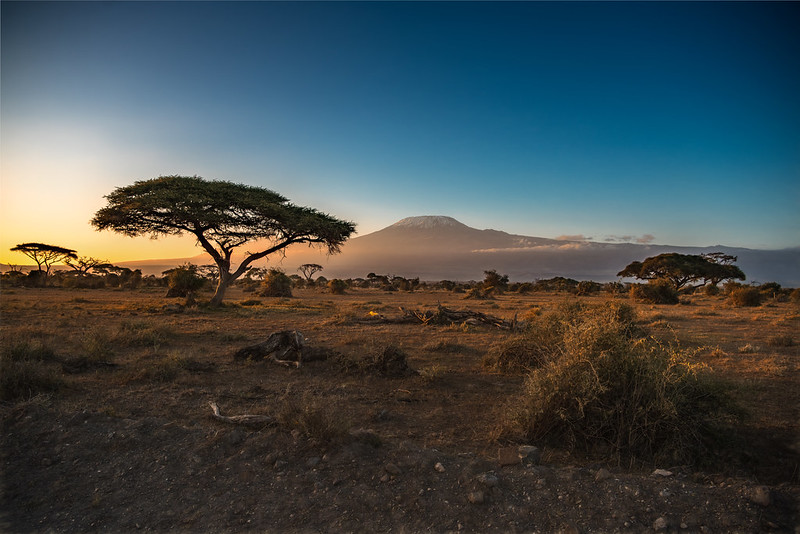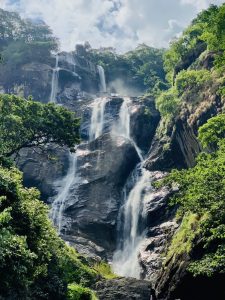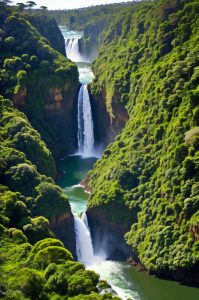Mount Kilimanjaro National Park
In northern Tanzania’s rolling hills and plateaus lie the snow-caped peaks of Mt. Kilimanjaro and The Mount Kilimanjaro National Park. With slopes and glaciers sparkling above the intensifying clouds in the sky at 5896 meters. Mt. Kilimanjaro is the highest point in Africa followed by Mt Rwenzori in Uganda and Mt. Kenya in Kenya. Not to forget Mt. Kilimanjaro is the tallest stand-alone mountain in the world. It’s located in Moshi town and controlled for climbers to enjoy without leaving touches of their presence. The highlights for visitors to Mt. Kilimanjaro are the hikes that offer you breath taking views on the rooftop of Africa. Kilimanjaro claims the splendor sights of the Amboseli National Park in Kenya, the great rift valley and the Masai grassland. Don’t miss out on an adventure of a lifetime where seasoned trekkers and first-time fanatics can gauge the snow peaks.
Attractions in the prk
The peaks of Mount Kilimanjaro
Mountain Kilimanjaro has 8 peaks and all offer you sights of beautiful scenery as well as unique features as below;
Kibo Peak
This is the most beautiful of all the peaks since its snow-capped all year round yet it’s close to the Equator line.
It’s the highest of all with 5895 meters tall and reaching the peak is conquering a life time adventure. This peak alone has made Mt. Kilimanjaro the roof top of Africa.
Mawenzi Peak
This is the most difficult peak to climb during your hike of Mt. Kilimanjaro and requires specialized skills and knowledge.
As a hiker you will only be permitted when you have the equipment’s and a technical climber.
The rugged peak is the second tallest at 5149 meters.
Shira Peak
This was once the tallest peak on Mt. Kilimanjaro but collapsed 750 years again. This is the third tallest peak at 3962 meters and with a number of tourism activities. In addition, when it collapsed it led to the formation of the Shira plateau with its magnificent scenic views of Kilimanjaro. The open grassland on the plateau has attracted habitants of wildlife from Buffaloes, elephants, elands and different types of monkeys. They use the Shira plateau for feeding and salt licking. Furthermore, the peak has a point called cathedral and Needle that hikers can climb on a day excursion
Montane Forest
The montane forest zone is worth a visit even if you aren’t climbing the peaks with its different plant species like the endemic Impateins Kilimanjari. This forest circles the entire Kilimanjaro and thanks to Kilimanjaro’s beauty. This fold was from 1800 – 2800 meters tall and 96% of water originating from this zone.
Kifinika Cultural Sites
This is one of the ritual grounds for the Masai and Chagg people back in the days. This site will provide you with the historical life of the two tribes. This site is located along the Marangu route and it was mainly used for cultural rituals.
Lake Chala
This is located outside of the park but one of the must visit sites on your Mt. Kilimanjaro expedition. It’s 30 minutes from Himo town to get to this lake that draws it’s waters underground from Kilimanjaro. You can plan to visit this lake before or after your hike.
Water falls
Mt Kilimanjaro has two falls that you will encounter during your hikes
Marangu waterfall 1km and Lauwo waterfall 2.8 kms along the Marangu route which will provide picturesque experience during your walk in the thick montane forest.
Maundi Crater
This crater lake offers you a bird’s eye on the scenic beauty of all the lakes in Mt Kilimanjaro. These include Lake Chala, Jipe and Nyumba ya Mungu. This is located just 15 minutes past Mandara hut and Marangu route
Wildlife
Mt. Kilimanjaro boasts of a number of animals and birdlife that hikers encounter during there summit. This mountain has 25 Antelopes, 140 different types of Mammals, 7 Primates, 24 different Bats, 179 Bird Species And 25 Carnivores
Examples: Buffaloes, Elephants, Eland, Black & White Columbus Monkey, Blue Monkey, Duikers and Myosorex Zinkii
Activities in Mount Kilimanjaro National Park
Mt Kilimanjaro has a number of activities that will woo you during your safari as per below;
Mountain Climbing
This is the popular activity in Mt. Kilimanjaro that takes you to the highest point in Africa. Most of the tourists or visitors that come to the park are either interested in climbing or seeing mountain. This activity is divided into six mountain trails that will aid in conquering Kibo peak the tallest of them all.
Depending on which route you take and the cost rangers from $1000 – USD700 0. Please note that the Marangu route is the easiest and lazy climbers or hikers take 5 – 6 days to get to the summit.
For the scenic beauty lovers, the Machame route is the best and will meet your expectations but more strenuous. The hiking time will always vary from three (3)- eight (8) hours per day.
Each of these routes will offer you different challenges and attractions. When you have 1 or 2 days you can still hike the mountain as a day tripper or a one-night hiker.
Wildlife Viewing
The Mount Kilimanjaro National Park has both small and big gem that offers tourist sights of different wildlife. We advise that if you have altitude problems Kilimanjaro isn’t a place for you since the ground level is still above sea level.
Examples: Buffaloes, Elephants, Eland, Black & White Columbus Monkey, Blue Monkey, Duikers and Myosorex Zinkii
The activity starts at 8am to 19 hours every day in guidance of an armed ranger guide to protect you from carnivores like leopards.
Paragliding
This is another activity that you can take part while at Mt Kilimanjaro as you freely fly the biggest free-standing mountain in the world.
Crater Camping
This is activity offers you a chance to experience the unique night life in Mt Kilimanjaro. You will visit the unique bench shaped glaciers that can only be found in Kilimanjaro.
Filming
This mountain beside attracting climbers, it also attracts filming crews and photographers. Examples of films shot in Mt Kilimanjaro are Snows of Kilimanjaro in 1952 and worn 2 Oscar Academy Awards. They charge a filming fee of $250 per person per day which includes camping. Conservation fee and filming fees.
Cycling
Mt Kilimanjaro offers you a chance to cycle within the park as you do more of sightseeing. During cycling, your ranger guide will choose from two routes that is Kilema route and the famous Shira plateau. Activity is scheduled from 8am to 18:30hrs and all routes have picnic sites and resting points.
Where to stay
Accommodation is inclusive of the hiking fee you pay and on top of the mountain there huts in which every hiker stays. These are found on all the stop over points on top of the mountain. Below are some of the huts and camps;
- Kilema camp
- Horombo Huts
- Kibo Hut
How to get there
You reach Mt. Kilimanjaro through Mosh and Arusha town and it takes approximately 1-2 hours and below are the different transportation ways;
By Road
This is the most common type of transportation to the park and it will take you approximately 2 hours from Arusha town covering 123 kms.
When you are coming from Mosh it’s 48 kms and it will take approximately 1 hour to reach Marangu (Park headquarters). The roads are in good condition but as you get closer to Mt. Kilimanjaro, the roads are Marram and you may experience the African Massage.
We recommend you use a 4×4 Vehicle and this ranges from Us dollars $200-$350 per day minus drivers’ allowance.
By Air
The air transportation is scheduled or chartered from either Kilimanjaro International Airport or Arusha and below are the companies that operated that route;
- Coastal Aviation flies to Mt. Kilimanjaro National Park
- Air Tanzania flies to Kilimanjaro
- Zan Air flies to Arusha
- Precision Air flies to Arusha and Kilimanjaro
However, once you are there you will need to use road transportation to reach the park still and it’s 86 kms to Marangu park headquarters. This drive will take you approximately one hour thirty minutes (11/2 hrs.).




